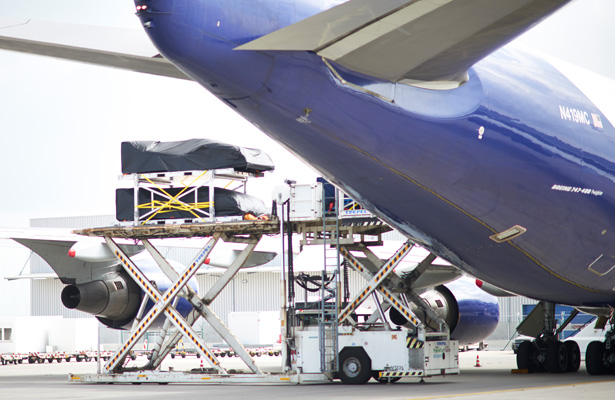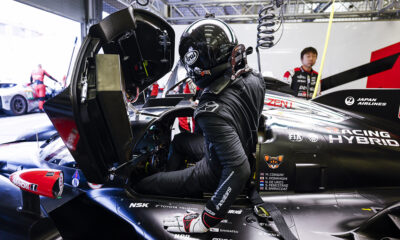
Photo: Porsche
Entering the two highly complex Porsche 919 Hybrids at the overseas races of the 2014 FIA World Endurance Championship does not just pose new sporting challenges for the Porsche Team. The logistics are a race of their own for the LMP1 newcomers from Weissach.
The travel itinerary for the second part of the World Championship, with Austin (USA), Fuji (Japan), Shanghai (China), Sakhir (Bahrain) and Sao Paulo (Brazil) as the destinations, adds up to around 25,000 miles – which is almost exactly equivalent to a trip around the globe.
The team’s air freight for this enterprise is 35 tons. Nevertheless, only indispensable items are taken on board. The team’s hospitality, for example, isn’t one of the essentials. The works team eats in the paddock canteen.
Air cargo is complex. Like in the classic computer game Tetris, items have to be stacked without gaps, using the aircraft’s hold including any sloping sections. The area for the Porsche freight is limited to 12 units. Each of them measures 304 by 230 centimeters and, when fully loaded, should not be heavier than 3000 kilograms, otherwise the basic costs increase.
Months ago it was calculated it was 12 units that would be needed. The cargo list contains several thousand items. In order to ensure that everything fits into the limited space, the team always had the air freight requirements in mind when making decisions over what to purchase – whether for a tool cabinet, packaging for the drivers’ helmets, or an engine box.
Furthermore, similar to moving house, the rule is: whatever is needed first at the destination, must be immediately available. Perfect organization is essential to build up the garage on time, and once a three-ton container has been unloaded in a freight packed pit lane it sits there until it is empty.
The air freight goes on an Atlas Air 747 cargo plane, chartered by DHL and shared with other WEC teams. It took off on September 11 from the Frankfurt-Hahn airport in Germany to fly to Austin, Tokyo, Shanghai, Manama and Sao Paulo.
Obviously the Porsche Team had to arrange everything from scratch in its debut season.
Ten tailor made containers have been purchased. Six of them, the so called Q7, have sloping tops, two are the flatter Q6 and two are “winged lowers”, shaped especially for the lower cargo space in the aircraft. They are more efficient than anything you can buy ready-made, and save a lot of packing material compared to stacking single boxes one on top of another.
Each Q7, for example, is 120 kilos lighter than those normally used in Formula One. Plus, it can be loaded onto the aircraft with no net around it, which saves another 1.3 centimeters in height.
Alongside the ten lightweight containers, the remaining two units accommodate the big parts, such as the flight case with the spare chassis or the hundred wheel rims.
Each of the 12 units has a unique worldwide number plate and each component packed inside the containers has a QR code, so that by using a scanner everything can be located.
This painstaking organization doesn’t just achieve labour and cost efficiency. Customs offices, too, have a need for information. Whether the serial numbers of the 120 radios, the number of chassis components, packets of screws, or rolls of tape – Porsche puts a lot of effort in reliable documentation.
Everything imported into the various countries has to be exported out again. The containers are x-rayed, and customs officers may, of course, want to unpack them. Time for this is factored into the schedules.
The two race cars don’t fit into containers. The Porsche 919 Hybrids travel securely strapped down onto extra car racks. All of their fluids have been drained, fragile body parts, such as the wing mirrors and front and rear wings, have been packed safely elsewhere.
Fitting a set of used tires is just right for traveling around the world. Between the races some components go back and forth. For example, the two-liter four-cylinder engines for rebuilding in Weissach.
Hazardous materials go separately. These include adhesives and resins, as well as spray cans and the lithium-ion batteries for the hybrid drive systems. These batteries even require permission from federal aviation administration offices in the various countries.
The fact that Porsche possesses considerable expertise in hybrid matters helps the race team, but the procedures are time-consuming nonetheless. The hazardous materials also have to stay in a secure room for 48 hours before and after every flight without being moved.
Fuel is shipped by Porsche’s partner Shell, and ExxonMobil brings all the oils and lubricants to the tracks. Michelin sends the tires.
The team also ships some items by sea, which is considerably less expensive, but also much slower. Equipment shipped in August will only return in January. But then this doubles or triples what is needed. Because of the long distances there are three sets of sea freight on the high seas.
The contents consist of relatively inexpensive but heavy equipment. Metal posts, for example. Instead of flying 20 of those heavy Tensator barriers around the world, it is cheaper to buy sixty of them and load them onto three vessels. It’s all about efficiency.






















